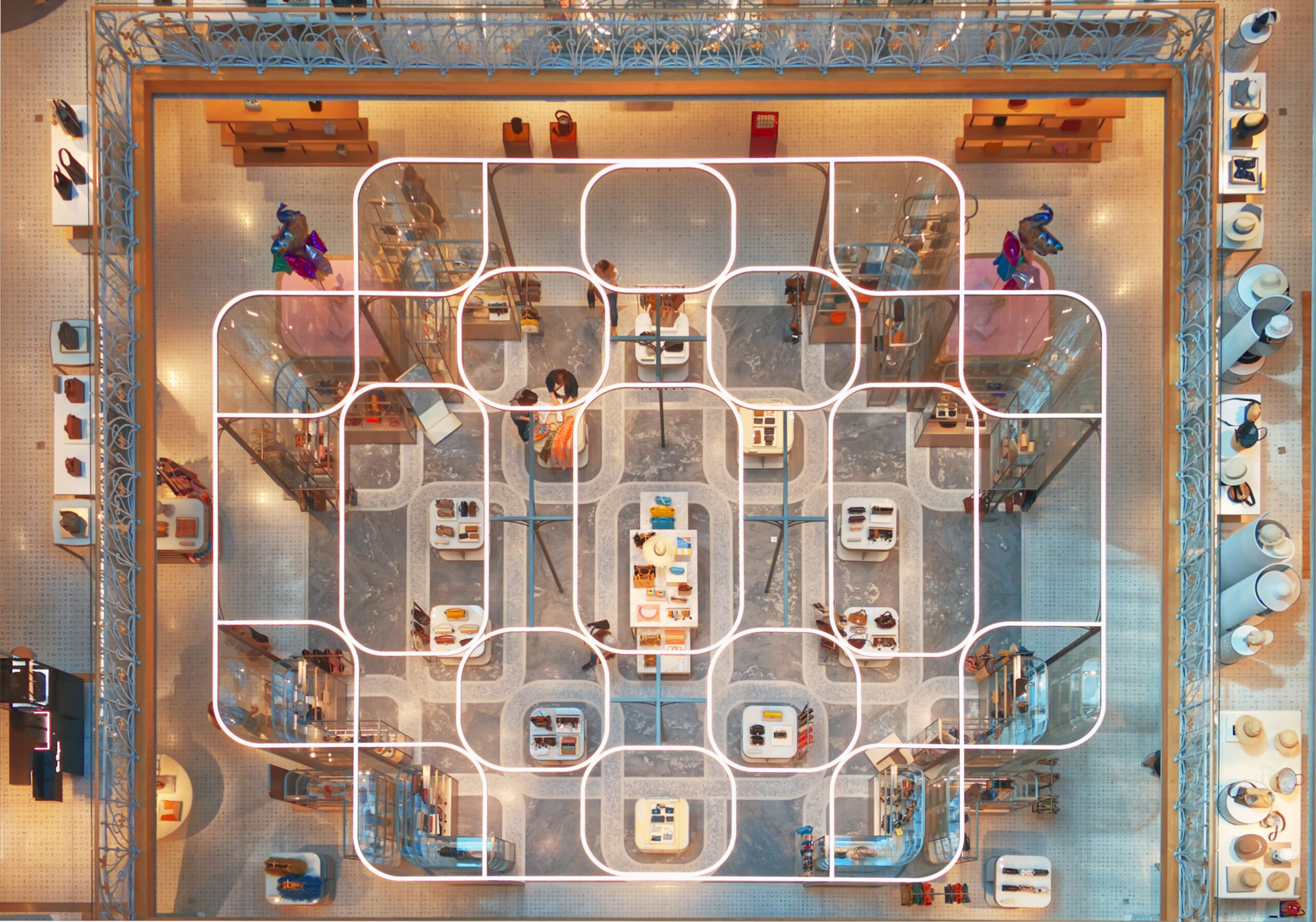This is part 3 of a 3-part series.
The future is collaborative, but not in the way most consumers are prepared for – rather, it’s their data that will be collaborating with stores and retailers with whom they’ve opted in, shared their browsing and purchase histories, and whittled down their preferences. The seamless blending of the physical retail experience and digital browsing experience will be almost indistinguishable from one another – omnichannel may not even accurately describe it.
Maybe metachannel?
“By 2030, a routine trip to the store will be nothing short of a sensory journey, with digitized, interactive displays, curated scents and in-store playlists (powered by CMS solutions) working in tandem to create immersive and captivating experiences,” said Jaime Bettencourt, SVP of revenue and brand at Mood Media, to TFI.
“Customers will step into a retail environment where every interaction is personalized, guided by AI algorithms that efficiently navigate shoppers through aisles and offer tailored product suggestions in real time,” fostering brand loyalty and elevating the consumer experience to “unprecedented satisfaction levels,” he added. Tom Summerfield is retail director at Peak, and he sees retail in the future as being more transparent.
“For retailers, the days of blanket promotions through loyalty card schemes will be over,” he said to TFI. Most cards will probably be digital, anyway, and personalized pricing – based on purchase frequency, inventory demand, and more “made-perfect-for-you” factors, will be proffered via in-store media networks and the AI platforms upon which they operate.
“Dynamic, personalized pricing, with shelf edge technology – powered by AI – will enable each and every customer to access private pricing based on their loyalty, preferences and purchase frequency, whether they’re shopping on social media, website, or in store,” Summerfield added.
Summerfield said that the most significant impact from AI will be how it enables retailers like Target, Walmart, and more to achieve true one-to-one personalization using real-time and interactive digital content.
“Shoppers both expect and reward this,” he noted. “Ninety-one percent of consumers say they are likelier to shop with brands that provide relevant offers or recommendations, and according to McKinsey data, 71% expect personalization. By optimizing customer communication, putting customers at the center of decision-making by understanding their needs, and crafting relevant offers and marketing, AI will create more rewarding connections and deeper relationships between retailers and their customers.”
It might be easy to conflate the influx of money, marketing, time, and resources into today’s retail environments as a false flag that actually ignores the consumer experience in the name of keeping up with the competing Joneses (and Amazons, and Targets, and…), but the consumer experience is exactly what all this technology is about.
“The ease of the customer experience is crucial to the success of the store and top of mind for retailers,” Huffling added.
“Customers will continue to value continuity in the store, online, and on their mobile devices. Ultimately, the retailer wants to deliver a customized user experience to their customers through unique messaging, rewards, and marketing. Mobile technology, electronic shelf labeling, and personal shopping services will continue to evolve and remain important in enhancing this customer experience.”
Bespoke Experiences Will Define Brick-and-Mortar
Another real-world shift is at hand – instead of consumers exerting their will upon the physical retail environment, the store itself will anticipate, respond, and guide consumers through their shopping experience.
“Imagine a store where displays respond dynamically to movement, music adapts to individual moods, and content caters to diverse preferences,” said Paul Brenner to TFI. Brenner is SVP of retail media and partnerships at Vibenomics, a Mood Media company.
Brenner said that 2024 “marks a turning point in standardizing in-store technology, addressing the current fragmentation of disparate, incompatible solutions.”
Retailers are actively exploring and experimenting with digital technology, aiming to cultivate an environment where advertisers flourish and shoppers have an enhanced experience. Through continuous testing and learning, retailers are refining their digital investments, fostering an ecosystem of mutual success for themselves and providers.”
Brenner also noted that though people are increasingly wary of (and often exhausted by) the proliferation of digital screens in their pockets, in their vehicles, at work, at home – everywhere – yet the opportunities it affords them will be too hard to ignore. And that’s where retail media networks (RMNs) come in.
“Retail media networks will also play a crucial role in this future by helping retailers leverage shopper data to deliver personalized experiences via data collection and insights gathered from online browsing history, purchase behavior, and in-store interactions,” he said. “Retailers can leverage RMNs to deliver targeted advertising and promotions to customers based on their individual data profiles. RMNs also enable the personalization of in-store content and displays, showcasing products, recommendations and information tailored to individual customer preferences to create a more relevant, engaging experience.”
Seamlessly blending the digital and physical elements while leveraging RMNs loaded with consumer data will empower retailers and stores to deliver bespoke experiences, services, and offers catered to individual preferences and purchase history, lifestyle, and even nutrition, all in the name of driving sales, fostering loyalty, and spreading the brand message that this store provides more value than its competitors.
“Retail has a bright future ahead,” said Jaime Bettencourt, SVP of revenue & brand at Mood Media.
“Additionally, the widespread adoption of Internet of Things (IoT) technology will empower retailers to effortlessly gather and analyze insights into customer behavior, enabling more informed decision-making and personalized experiences…By embracing these trends and technologies, retailers can illuminate a path toward growth and differentiation in a fiercely competitive market.”
In other words, the future of retail is coming. And once it gets here – once these implementations are in place and the tech has caught up with speculation (and probably exceeded it), it will be hard to ignore. As store sizes shrink and consumers become more savvy about how and why they purchase the items they do, retailers will have to stay on the edge of the waves of technology and consumerism, stay nimble, and continue to provide value in the lives of their consumers.
To do anything less simply isn’t going to be viable.












